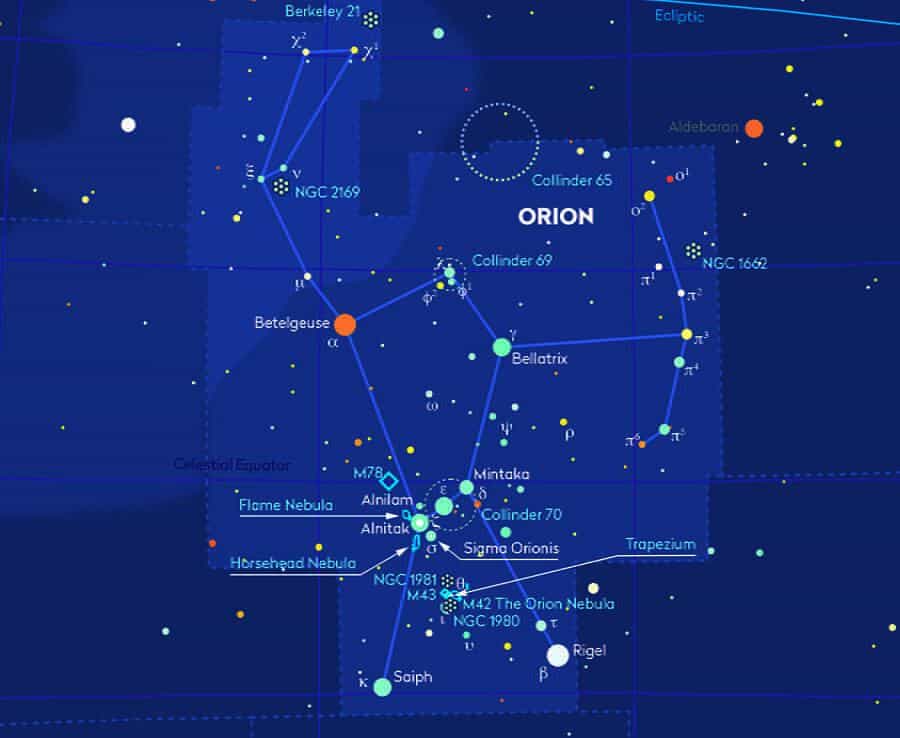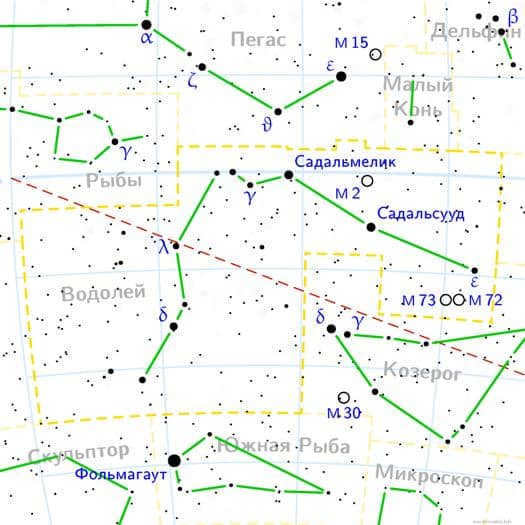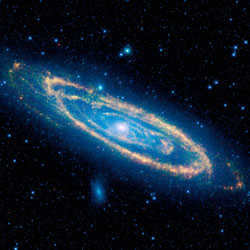
Science
The night sky is filled with an abundance of incredibly stunning objects that are visible even without any special equipment. If you don’t have any astronomical tools at your disposal, worry not, as there are still plenty of awe-inspiring sights to behold.
You can marvel at magnificent comets, luminous planets, distant nebulae, shimmering stars, and captivating constellations in the night sky.
However, it is crucial to bear in mind the issue of light pollution caused by large cities. In urban areas, the intensity of artificial light from street lamps and building windows often obscures the most fascinating celestial phenomena. Therefore, it is necessary to venture out to the countryside in order to witness these incredible spectacles.
Light pollution
Light pollution is a term used to describe the excessive or misdirected artificial light that is produced by human activity. It is most commonly associated with urban areas, where the bright lights from streetlights, buildings, and advertisements can create a glow that obscures the stars and other celestial objects in the night sky. Light pollution can have a range of negative effects, including disrupting ecosystems, harming human health, and obscuring our view of the universe. Efforts are being made to reduce light pollution through the use of more efficient lighting technologies and better design practices.
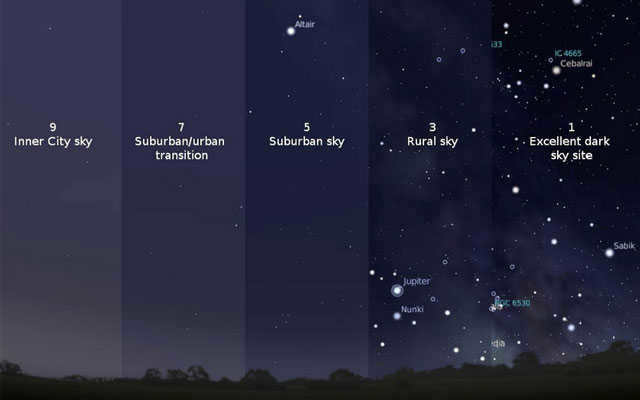
Venus: The Shining Star of the Sky
Venus, Earth’s scorching hot neighbor, can proudly claim the title of being the most luminous planet in the celestial expanse. The brilliance of this celestial body can be attributed to its remarkably reflective clouds and its close proximity to Earth. In fact, Venus shines approximately six times brighter than its celestial counterparts, Mars and Jupiter.
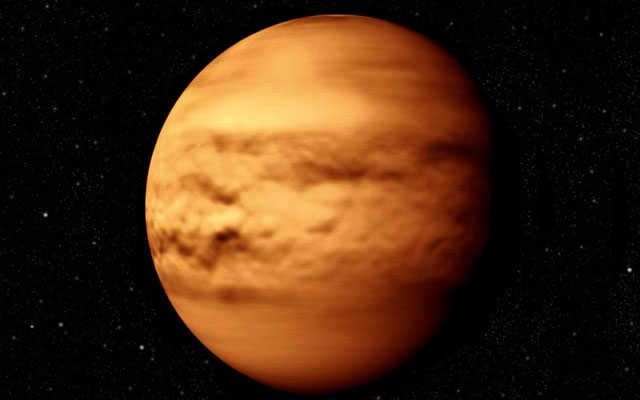
Venus is the most brilliant object in the night sky, except for the Moon. It has a maximum apparent magnitude of approximately -5. By contrast, the full Moon has an apparent magnitude of -13, making it approximately 1600 times brighter than Venus.
In February 2012, an extraordinary alignment of the three most luminous objects in the night sky was witnessed: Venus, Jupiter, and the Moon, which were visible shortly after sundown.
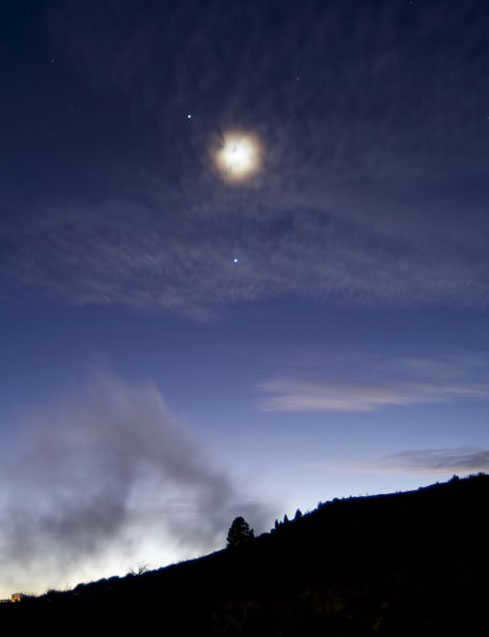
Biggest star
The biggest star discovered by scientists is VY of the Canis Major constellation, which is an M-type red hypergiant located approximately 3,800 light-years away from our planet. It is situated in the Canis Major constellation, which is 3,800 light years away from Earth.
According to scientific estimates, VY Canis Majoris could have a size more than 2,100 times that of the Sun. If placed within our solar system, this colossal star would extend beyond the orbit of Saturn.
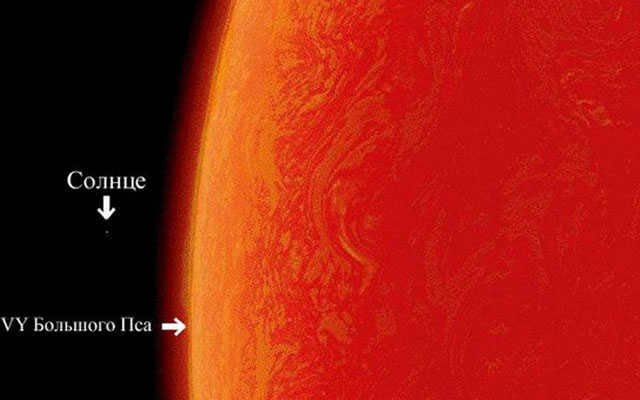
The outer appearance of the hypergiant cannot be easily discerned, as this star is approximately 1,000 times less dense than the atmosphere at sea level on our planet.
VY Big Dog has sparked considerable debate within the scientific community due to estimations of its size surpassing current stellar theories. Astronomers predict that VY Big Dog will undergo a collapse within the next 100,000 years. After this period, it will explode and perish, transforming into a hypernova and emitting an immense amount of energy, surpassing that of any other supernova.
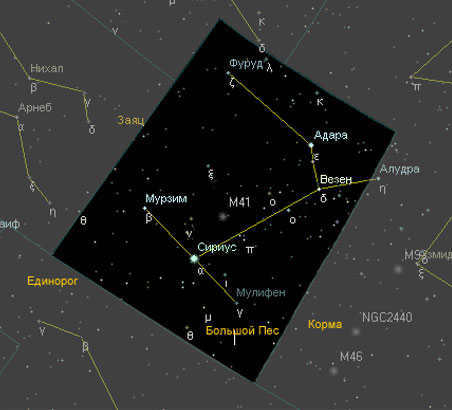
The most luminous star
In 1997, astronomers made a remarkable discovery using NASA’s Hubble Space Telescope. They found the most luminous star ever observed, located an astonishing 25,000 light-years away from our planet. This star, which is 25,000 light-years distant, radiates an incredible 10 million times more energy than our Sun. Not only that, it is also significantly larger than our own star. In fact, if we were to place it at the center of our solar system, it would completely engulf the orbit of Earth.
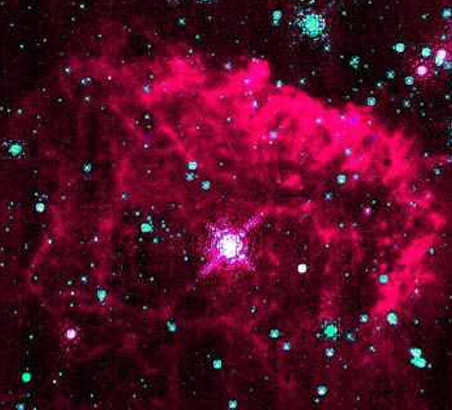
Scientists have proposed that this massive star, situated near the Sagittarius constellation, generates a gas cloud around it known as the Pistol Nebula. As a result of this nebula, the star is also referred to as the Pistol star.
Regrettably, this extraordinary star is not visible from Earth as it is concealed by the dust clouds of the Milky Way. The most brilliant star in the nocturnal sky is Sirius, situated in the Big Dog constellation. Sirius has a stellar magnitude of -1.44.
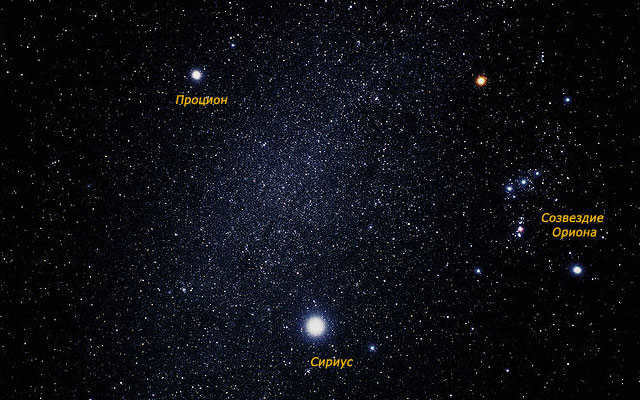
The star Sirius can be seen from any location on Earth, except in the northern regions. The brightness of the star is not solely attributed to its high luminosity, but also to its relatively close distance. Sirius is positioned approximately 8.6 light years away from our solar system.
The sky’s most stunning star
Many stars are renowned for their dazzling displays of various hues, such as the Albireo system, which features both blue and orange stars, or the vibrant red giant star known as Antares. However, the most breathtaking star visible to the naked eye is Mu Cepheus, a radiant red-orange celestial body. Mu Cepheus is also referred to as Herschel’s Garnet Star, paying homage to its initial investigator, the esteemed British astronomer William Herschel.
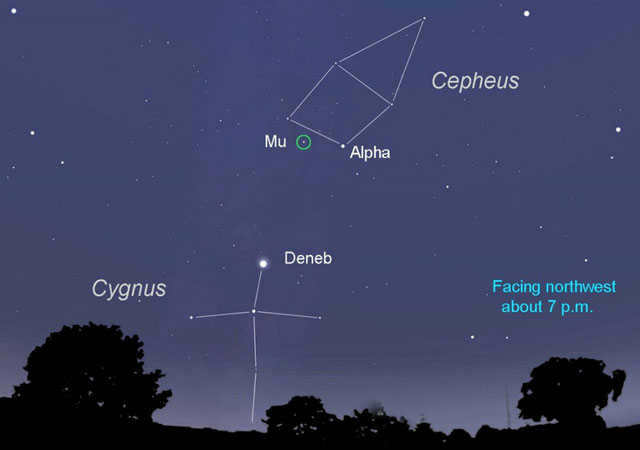
Located in the constellation Cepheus, the red giant Mu Cepheus is an interesting celestial object. It is a pulsating variable star, meaning that its brightness fluctuates. At its brightest, it can reach a magnitude of 3.7, while at its dimmest, it can drop to a magnitude of 5.0. Not only does its brightness change, but its color does too. Most of the time, it appears as a deep orange-red, but occasionally it takes on a mysterious purple tint.
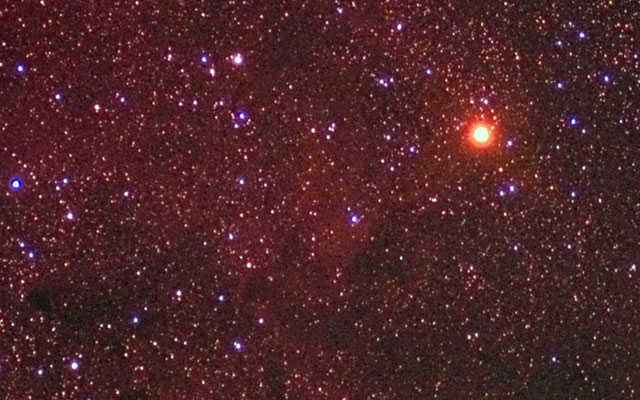
Although Mu Cepheus appears faint, its distinctive red color can still be observed without any visual aids. However, when using a pair of binoculars, the view becomes even more remarkable.
The most distant celestial object
The most distant object that can be seen with the naked eye is the Andromeda galaxy. Composed of approximately 400 billion stars, this galaxy was first documented in the 10th century by the ancient Persian astronomer Al Sufi, who referred to it as a “small cloud.”
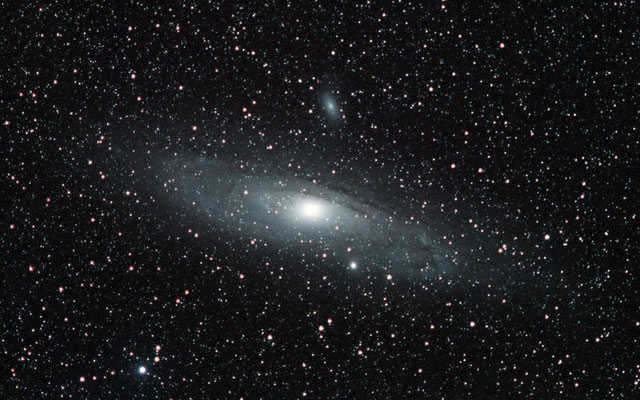
Even with the aid of binoculars or a beginner’s telescope, Andromeda still appears as a slightly elongated, indistinct shape. Nevertheless, it remains incredibly awe-inspiring, particularly when considering that it takes a staggering 2.5 million years for light to travel from there to us.
Incidentally, the Andromeda galaxy is currently moving towards our own Milky Way galaxy. Scientists predict that the two galaxies will collide and merge in approximately 4 billion years, resulting in Andromeda being visible as a luminous disk in the night sky. However, it remains uncertain whether there will be any observers remaining on Earth who are willing to gaze at the heavens after such a prolonged period.
The Taurus constellation is comprised of numerous stars, but within it, astronomers have identified a cluster of prominent stars. These stars are sufficiently bright to be easily visible from Earth, although they are situated at varying distances from our solar system.
Aldebaran
Aldebaran is the brightest star in the constellation, situated in the figurative head of Taurus. It is classified as a normal giant and emits a reddish-orange hue. Being a mere 65 light-years away from Earth, it can be readily observed in the night sky without the aid of a telescope. Presently, Aldebaran is expanding in size as a result of helium burning. Its diameter is currently 38 times larger than that of the Sun.
Fun fact: Aldebaran is often referred to as the “eye of Taurus” due to its placement just below the constellation’s “horns”.
Nat
The star known as Nat is the second brightest star in the sky and is about 5 times larger than the Sun. It is situated on the border of the constellation Ascendant, which has led to some confusion among ancient astronomers who alternately assigned Nat to both constellations.
Nat’s brightness is further enhanced by a nearby smaller star, creating what is known as a “double star” system. Through observations, scientists have determined that Nat is currently undergoing a transformation into a gas giant, although it still has a long way to go before reaching this status.
This term immediately refers to a group of stars that are in close proximity to one another. Astronomers have given them the names A, B, C, and D for simplicity. Each star belongs to a different class and possesses a unique level of brightness. Among them, there are both blue-white giants and yellow dwarfs. When observing the night sky with a telescope that lacks high magnification, Alcyone will appear as a single star.
Alcyone is a young star located at the center of a vast hydrogen nebula. The core of this celestial body attracts the surrounding material of the cloud, causing it to gradually transform from a disk shape into a complete sphere.
Interesting fact: The mass of the nebula is 1,000 times that of the Sun, making T Taurus a large and brilliant object during its final formation stage.
Electra
Electra is a massive celestial body that rotates at an astonishing speed of 181 km/h. This rapid rotation causes it to release a remarkable gas cloud into the vastness of space, gradually diminishing its mass. Additionally, the intense motion causes Electra to stretch at its equator, resulting in a flattened shape at its poles.
Merope
Merope, on the other hand, is a subgiant star whose core has depleted its hydrogen fuel. However, the star still possesses a sufficient amount of this element in its shell, allowing it to emit a dazzling brightness that is 630 times more intense than the radiance of our Sun. Merope can be found within a nebula, but even through this cosmic cloud, its luminosity effortlessly reaches Earth in a relatively short span of 360 years, which is quite remarkable in astronomical terms.
How to Start Exploring the Constellations
Recognizing the shapes of constellations can be challenging for beginners, especially with the multitude of stars in the night sky. Furthermore, the outlines of constellations can be distorted on star maps due to the specific nature of map projections. However, there’s no need to lose hope – experience comes with time, and eventually, after a few unsuccessful attempts, you will finally spot what you’ve been searching for. You’ll wonder how you missed it for so long…
To make your journey easier, it’s advisable to follow a certain algorithm when getting acquainted with constellations. Start with the brightest, most prominent, and well-known constellations. These can serve as landmarks and reference points for locating others.
For those who live in the Northern Hemisphere, the constellation known as the Big Dipper, which is located near the pole, can serve as a useful starting point for stargazing. In middle latitudes, it can always be seen above the horizon, and in the evening, it is quite easy to locate its distinctive “bucket” shape, which is made up of seven stars. During the fall, the Big Dipper can be found not far above the northern horizon, while in winter, it is positioned higher up in the northeastern part of the sky. In the spring, it can be seen high in the sky, almost directly overhead (in Moscow, it would be almost at the zenith). In the summer months, it can be found in the northwestern part of the sky.
The Big Dipper is not only useful for finding its own constellation, but it also serves as a helpful reference point for locating other stars and constellations. One well-known method for finding the North Star, Polaris, is by extending an imaginary line from the outer side of the Big Dipper’s “bucket”. However, as illustrated in the diagram, many other constellations can also be found using this prominent group of stars.
The following task is to locate the constellations that can be seen in the evening sky in the southern region during specific seasons of the year. During autumn, the constellations Pegasus and Andromeda are particularly prominent, and when observed together, they resemble a larger version of the Big Dipper, known as the Bucket. Once these constellations have been identified, one can proceed to search for Aries and Perseus, followed by the fainter ones such as Pisces, Triangle, and Whale….
The primary celestial figure during the winter season is undoubtedly Orion, with its magnificent “archer” adorned with the dazzling Betelgeuse and Rigel, as well as its distinct “belt” consisting of three stars. Extending this “belt” upwards and downwards, we encounter other luminous stars such as Aldebaran in Taurus and Sirius in the constellation Canis Major. Additionally, one can explore the remaining constellations of winter, including notable ones that feature first magnitude and brighter stars like Gemini, Ascendant, and Canis Minor, as well as fainter ones such as Monoceros and Lepus.
Transitioning to the spring sky, the prominent constellation Leo takes center stage, boasting the brilliant Regulus. Once Leo is located, it becomes effortless to spot other radiant celestial bodies such as Arcturus in Bootes and Spica illuminating Virgo. From there, one can embark on a search for the more obscure constellations of Cancer, Corvus, Crater, Hydra, Leo Minor, Sextans, and Coma Berenices.
During the summer and autumn seasons, there are three prominent stars that can be seen in the southern part of the sky: Vega, Deneb, and Altair. These stars are the focal points of the Lyra, Swan, and Eagle constellations respectively, but together they form what is known as the Autumn-Summer Triangle. It is recommended to begin your exploration of the summer sky with this triangle, and then proceed to locate other summer constellations such as the Northern Crown, Hercules, the Serpent with the Snake, Scorpio, Sagittarius, Capricorn, Aquarius, the Fox, the Dolphin, the Arrow, and the Shield.
Online star charts are available on the internet, which provide a view of the starry sky at the present moment as well as any desired hour in the past or future.
Notes
- ↑ Kononovich E. V., Moroz V. И. General course of astronomy: textbook / edited by V. V. Ivanov. V. Ivanov. – Moscow : Unitorial Urss, 2004. – P. 14. – 544 p. – ISBN 5-354-00866-2.
- Б. A. Rosenfeld. Astronomy of the Islamic countries // Historical and Astronomical Studies. – Moscow: Nauka, 1984. – Vyp. XVII. – С. 78.
- Starry sky // Kazakhstan. National encyclopedia. – Almaty: KAZAK Encyclopedesy, 2005. – VOL. II. – ISBN 9965-9746-3-2.
- The stars of a constellation are named using the genitive case.
- Kulikovsky, Peter Grigorievich. Handbook of amateur astronomy. – M. URSS, 1971. – ISBN 5836003033.
- The Serpent constellation is divided into two parts: Serpens Caput (429 square degrees) and Serpens Cauda (208 square degrees).
- Avila, Francisco de. . www.kuprienko.info (A. Skromnitsky). – Religion of the Andes. Mythology and legends of the Inca and the people of Varochiri (Central Peru). List of celestial bodies. Date of publication September 28, 2009.
- Juan Polo de Ondegardo y Sarate. . www.kuprienko.info (A. Skromnitsky) (January 3, 2010). – Report on the beliefs of the indigenous people of Peru; p. 207. Accessed January 3, 2010.
- ↑ .
- . sim-basic. Date of publication June 15, 2020.
Further east from the Leo constellation, you can observe the constellations that are visible during winter: Gemini, Ascendant, Taurus, Little Dog, Great Dog, and Orion.
Charioteer, featuring its vibrant yellow star Capella (which means Goat), is situated in the Milky Way at the same distance from Cassiopeia as Swan, but in the opposite direction. Right beside it is the zodiacal constellation Taurus. Within this constellation, the most prominent star, Aldebaran, shines with a fiery red hue.
Around Aldebaran, a multitude of faint stars can be observed, forming a cluster known as the Hyades. Nearby, there is a denser group of stars called Pleiades, also known as the Duck’s Nest or Stozhar. The naked eye can discern six stars within it, while those with exceptionally sharp vision can spot up to eleven.
Located beneath the Taurus constellation lies the most radiant and captivating of all the constellations in the winter sky – Orion. Its shape resembles either a wrapped bundle of wheat or a majestic human figure. The belt of Orion consists of three equally luminous stars, which were also referred to as the Three Magi. Positioned in the upper left corner of the constellation is the remarkably bright red star, Betelgeuse, while the lower right corner boasts another extremely luminous white star, Rigel.
Directly below and to the left of Orion is the constellation known as the Canis Major, which features a prominent star named Sirius, shining brighter than any other star in the entire sky. On chilly winter evenings, Sirius can be seen directly to the south, resting low on the horizon, and producing a mesmerizing display of shimmering colors. With the exception of Jupiter, Venus, and occasionally Mars, no other planets outshine Sirius.
Adjacent to Taurus on the opposite side of the Milky Way lies the constellation of Gemini, featuring the prominent stars Castor and Pollux. Just below Gemini is the constellation of Canis Minor, which boasts a pair of bright stars, with the primary one named Procyon.
While the other constellations hold significance, they are comprised of dimmer stars and are less conspicuous to the naked eye when initially exploring the celestial expanse, thus making them more challenging to locate. Those interested in discovering them can consult a star chart.
Compilation of literary sources
How to locate Taurus in the night sky?
If you want to spot Taurus in the sky, it’s important to be familiar with the neighboring constellations. Taurus is situated between Gemini on the east side, Whale and Aries on the west side. Orion can be found to the south, while Perseus is located to the north.
The ideal time to observe Taurus is during November and December when the constellation is highly visible in Russia and appears prominently in the sky. With the naked eye, it’s quite easy to identify Taurus, thanks to the Pleiades cluster and the brightest star, Aldebaran. Aldebaran stands out with its red-orange glow, making it distinguishable from other celestial bodies.
Did you know? On May 11, the Sun enters Taurus and gradually moves across its boundaries.
To enhance your stargazing experience, you can use binoculars. Even with a magnification of 20x, you will be able to clearly see many of the significant objects within the Taurus constellation.
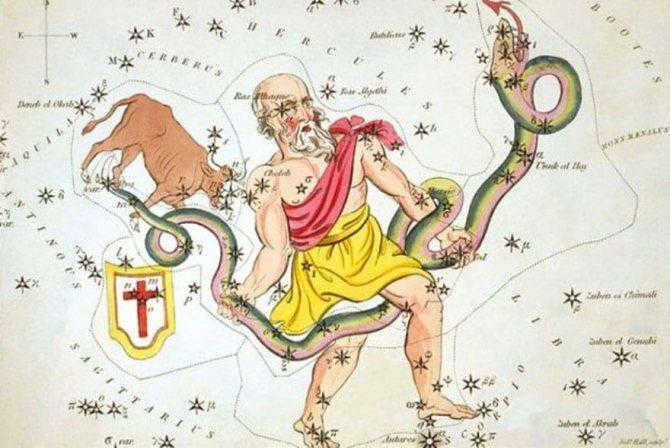
Within the elliptical solar path lies the constellation Serpentine, depicted as a male figure lifting a serpent above his head. The head of the Serpentine is marked by the star Ras Alhage. Asclepius, the renowned healer, is portrayed as a youthful man. Zeus, fearing that Asclepius would bestow immortality upon humanity, put an end to his life.
An eerie legend surrounds Erysichthon and his companions, who felled the forest of Demeter to construct a dwelling. Enraged, the goddess began to starve him. Despite his efforts to satisfy his hunger, Erysichthon could never satiate it. He consumed everything within his house and even resorted to selling his own children into slavery in search of more sustenance. Eventually, he reached the point of self-cannibalization, and upon his death, he was surrounded by snakes as a reminder of the peril of provoking a deity.
The constellation of Libra
Libra is a star cluster that has been historically regarded as unremarkable. It lacks the brilliance of other constellations and its shape is not easily discernible. The only visible star, located at the lower right side, has a faint greenish hue. It was first documented in the 1st century BC and was created by borrowing a part of Scorpius, another constellation. The Romans named it Libra during the early years of the new era.
Due to various changes in its name, the appearance of Libra was established much later than other constellations. Initially, it was portrayed as an altar and later as a lamp held by the Scorpion in its large claws. Only when the Scorpion released its grip, did the new celestial form of Libra take shape in the sky.
If the constellation of Libra appeared in the northern regions, it indicated to the people that it was time to sow crops. However, in Egypt, the appearance of Libra meant that it was time for harvest.
In Greece, there resided the beautiful goddess Astrea, who used a set of scales to determine the destinies of individuals. According to one legend, the appearance of scales in the sky signaled that people should adhere strictly to the laws.
Astrea’s parents were Zeus and Themis (the goddess of justice), who instructed her to make fair judgments. She accomplished this by blindfolding herself and using equal scales to make impartial decisions, assist innocent victims, and punish thieves and deceivers. Zeus decided that his daughter’s instrument of justice should be placed in the starry sky as a symbol of integrity.
Northern and southern constellations
Due to the spherical shape of the Earth and its orbit with a slight inclination, different constellations can be observed in the northern and southern hemispheres. In certain seasons, only some constellations located near the celestial equator can be seen above the horizon in both hemispheres.
The majority of constellations visible in the northern hemisphere’s middle latitudes are not visible in the southern hemisphere, and are therefore referred to as northern constellations. Conversely, many southern constellations are never visible in the northern hemisphere, particularly the polar constellations.
That is the reason why the residents of Russia will never get a glimpse of the Southern Cross, Indian, Microscope, and other constellations that are found in the southern hemisphere. To witness these celestial formations, one would need to travel south of the equator. Similarly, the residents of Australia will never have the opportunity to see the Cassiopeia, Lyra, Swan, and other constellations that are located in the northern hemisphere from the comfort of their homes.
Out of the total 88 constellations, only 36 of them belong to the northern hemisphere, leaving the remaining 52 constellations in the southern hemisphere. However, it should be noted that some constellations can be observed in both hemispheres, albeit they do not rise very high above the horizon. For instance, the Big Dog constellation with its prominent star Sirius, even though it falls under the category of southern constellations, can be perfectly seen in the middle latitudes of the northern hemisphere during winter. Additionally, other constellations such as Hydra, Unicorn, Whale, and a few others are also visible, either in their entirety or partially.
Initially, constellations were created based on the arrangement of prominent stars. Today, astronomers utilize them as points of reference in the sky.
Here is an alphabetical list of constellation names:
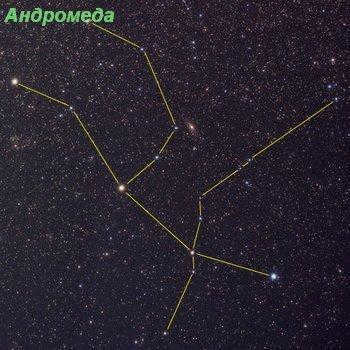
- The celestial sphere is situated in the northern hemisphere.
- Gemini is characterized by its bright stars, Pollux and Castor, and is known as a zodiacal sign.
- The Big Dipper is composed of seven stars that form the shape of a dipper.
- The Big Dog constellation boasts the brightest star in the sky, Sirius.
- Libra is a zodiacal constellation made up of 83 stars.
- Aquarius is another zodiacal constellation that forms the shape of a jug.
- The Ascendant constellation is most notable for its prominent object, Capella.
- The Wolf constellation is located in the southern hemisphere.
- Volopassus is a constellation with its brightest star being Arcturus.
- Veronica’s Hair is comprised of 64 visible objects.
- The Raven constellation is best observed in the middle latitudes.
- Hercules is a constellation that consists of 235 visible stars.
- Hydra’s most significant luminary is Alphard.
- The Dove constellation contains 71 stars in the southern hemisphere.
- Hound Dogs. There are 57 objects that can be seen in this constellation.
- Virgo. This is the zodiacal constellation that has the brightest body, which is Spica.
- Dolphin. This constellation can be seen everywhere except in Antarctica.
- Dragon. This constellation is located in the northern hemisphere and is practically at the pole.
- Unicorn. This constellation is located on the Milky Way.
- The Altar. There are 60 visible stars in this constellation.
- Painter. There are 49 objects in this constellation.
- Giraffe. This constellation can be faintly seen in the northern hemisphere.
- Crane. The brightest star in this constellation is Alnair.
- Hare. There are 72 celestial bodies in this constellation.
- Serpentine. This is the 13th sign of the zodiac, but it is not included in this list.
- Snake. There are 106 luminaries in this constellation.
- Goldfish. There are 32 stars that can be seen with the naked eye in this constellation.
- Indian. This is a constellation that can be faintly seen.
- Cassiopeia. This constellation has a shape similar to the letter “W”.
- Keel. There are 206 objects in this constellation.
- Whale. Found in the celestial region known as the “water” zone.
- Capricorn. The zodiacal constellation located in the southern hemisphere.
- Compass. Consists of 43 visible stars.
- Corma. Situated along the Milky Way.
- Swan. Located in the northern part of the sky.
- Leo. Zodiacal constellation found in the northern hemisphere.
- Flying fish. Contains a total of 31 celestial objects.
- Lyra. Home to the brightest star, Vega.
- Foxy. Known for its dimness.
- The Little Dipper. Positioned above the north pole and includes the star Polaris.
- The Lesser Horse. Comprised of 14 luminaries.
- The Lesser Hound. A bright constellation in the night sky.
- Microscope. Situated in the southern celestial region.
- Fly. Found along the celestial equator.
- Pump. Located in the southern part of the sky.
- Naugol. Passes through the Milky Way galaxy.
- Aries. A zodiacal constellation featuring the stars Mezarthim, Hamal, and Sheratan.
- The Octant is located at the south pole.
- The Eagle can be found at the equator.
- Orion has a bright star called Rigel.
- The Peacock is situated in the southern hemisphere.
- The Sails constellation contains 195 stars in the southern hemisphere.
- Pegasus is located south of Andromeda and its brightest stars are Markab and Enif.
- Perseus was discovered by Ptolemy and its first object is Mirfak.
- The Furnace constellation.
- The Bird of Paradise is located near the south pole.
- Cancer is a faintly visible zodiacal constellation.
- The Incisor is situated in the southern part.
- Pisces is a large constellation divided into two parts.
- Pisces has 92 visible stars.
- The Northern Crown has the shape of a crown.
- The Sextant is located on the equator.
- The Grid constellation consists of 22 objects.
- Scorpio’s first luminary is Antares.
- The Sculptor constellation contains 55 celestial bodies.
- Sagittarius. Astrological sign.
- Taurus. Zodiac sign. Aldebaran is the most prominent celestial object.
- Triangle. Consisting of 25 stars.
- Toucan. Location of the Small Magellanic Cloud.
- Phoenix. Comprised of 63 stars.
- Chameleon. Small and faint in appearance.
- Centauri. Proxima Centauri, its brightest star, is the closest to the Sun.
- Cepheus. This constellation has a triangular shape.
- Circulus. Located near Alpha Centauri.
- Clock. Notable for its elongated shape.
- Shield. Found near the celestial equator.
- Eridanus. A large constellation in the southern sky.
- Southern Hydra. Consisting of 32 celestial bodies.
- Southern Corona. A faintly visible constellation.
- Southern Fish. Comprised of 43 objects.
- Southern Cross. Taking the form of a cross.
- Southern Triangle. A triangular-shaped constellation.
- Lizard. Lacks prominent bright objects.
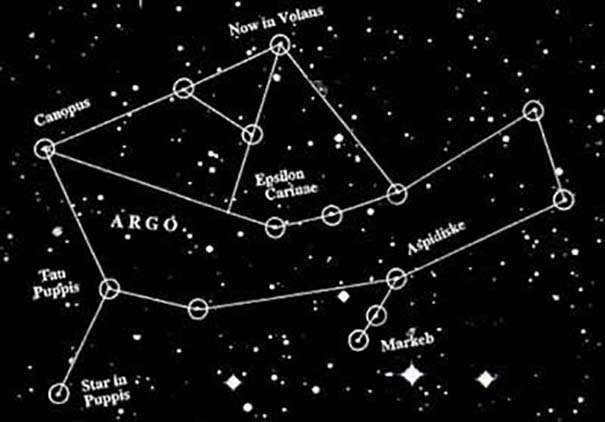
Once upon a time, there existed a constellation, which was subsequently split into individual constellations:
The constellations of the Great Bear, the Little Bear, and Volopassus.
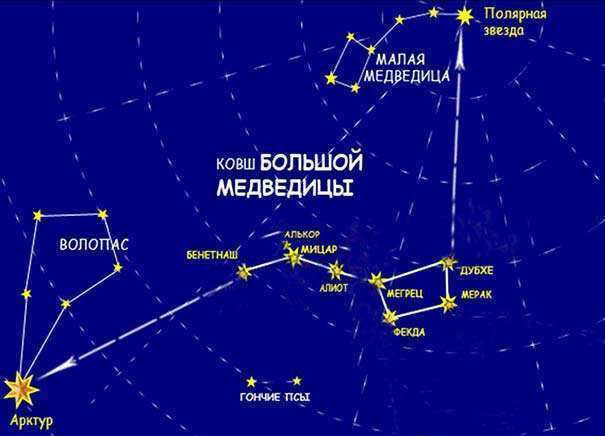
Upon observing the images depicting the constellation of the Big Dipper, one can become acquainted with various accounts regarding the origins of the names of the two bears. For instance, consider the following tale:
In the realm of Arcadia, Lycaon reigned as king. He had a remarkably beautiful daughter named Callisto, whose allure attracted even Zeus himself. The mighty god assumed the form of the handsome Apollo in order to seduce her. However, when Zeus’s wife Hera discovered their affair, her wrath knew no bounds. In her anger, she transformed the stunning Callisto into a fearsome bear. One day, Arkad, the son born from their illicit union, returned home from a hunting expedition to find a wild bear lurking near their dwelling. Filled with a desire to slay the creature, he was prevented by Zeus, who whisked his mother away to the heavens, where she transformed into the Big Dipper. As for the Little Bear, Zeus bestowed the honor of being Callisto’s cherished canine companion.
To ensure that Arkad always honors his mother, the supreme deity took him under his protection in the heavens, where he transformed into the constellation Volopassus. Hence, the names of the constellations and stars in the spring sky are not coincidental, as the primary star of Volopas Arcturus translates to “guardian of the bear.”
According to Greek mythology, Ethiopia was once governed by the ruler Cepheus and his spouse Cassiopeia, who had a remarkably beautiful daughter named Andromeda.
One fateful day, the queen carelessly boasted to the sea goddesses, the Nereids, about her own beauty and that of her daughter. These goddesses, being beautiful themselves, were greatly offended and demanded that their father, Poseidon, punish Cassiopeia.
He dispatched a colossal whale to lay waste to the land. The king and queen opted to offer up their daughter as a sacrificial offering. She was fastened to the rocky shoreline, where the climax was destined to unfold. Luckily, at that precise moment, Perseus was soaring above Ethiopia on his winged Pegasus, clutching the freshly-severed head of Medusa Gorgon. Observing the repugnant creature on the verge of devouring the maiden’s beauty, Perseus produced the Gorgon’s head and presented it to the monster, who instantaneously turned to stone. Thus, Perseus rescued Andromeda and, naturally, was rewarded with her hand in marriage as a token of gratitude. As a result of this tale, the subsequent constellations were etched into the heavens:
Later names for constellations
When researching the concept of constellations, including their images and names, it becomes apparent that newer constellations have adopted different naming conventions. Some examples include: Circulus, Telescope, Pump, Compass, Lizard, Sacrifice, Fly, Unicorn, and Giraffe.
Other constellations are connected to the Age of Discovery, such as: Triangle, Southern Cross, Indian, Dolphin, Flying Fish, and Peacock.
How many constellations can you spot in the night sky? Share your experiences with us in the comments.
Watch this video to learn more about constellations in the sky and their unique names.
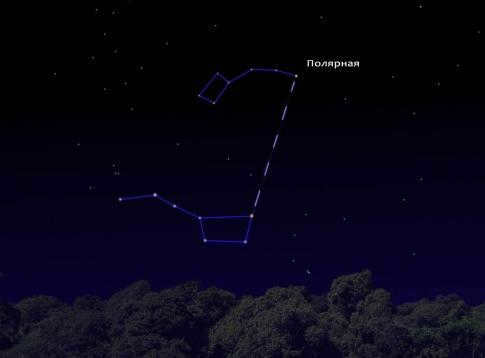
There are many different mythical stories and tales associated with the origin of this image. The Little Dipper is a small cosmic image that is perfectly positioned in the northern side. Since ancient times, it has been affectionately referred to as the “bear cub”. It was first recognized by astrologers in the 2nd century by a Greek astronomer.
Typically, the Little Dipper is depicted as a small bear cub with a large tail. The tail is believed to be long because the baby clings to the Earth’s pole with it.
Consisting of seven bright stars, this cosmic figure forms the shape of a scoop, with Polaris located at the end of the handle. This celestial formation is made up of multiple stars and is located approximately 430 light years away from Earth.
This particular star is widely renowned and holds great prestige in various domains. It is hailed as a guiding star due to its intense luminosity and distinct positioning, aiding lost sailors or hunters in finding their way back home.
The Bedouins have aptly nicknamed it the “goat” and it serves as an excellent reference point during nocturnal expeditions (the Canopus star being the second option for orientation).
Locating the constellation in the sky is quite simple. Its neighboring constellations include the Giraffe, Cepheus, and Dragon. However, in order to locate Ursa Minor, one only needs to know the position of Ursa Major. By finding the two stars on the edge of Ursa Major, counting five intervals between them, one can find Polaris. From Polaris, the “handle” of Ursa Minor begins, which is significantly smaller compared to the Big Dipper. It may not be as bright as its larger counterpart, but it is still clearly visible in the night sky. Ursa Minor can be observed year-round in the Northern Hemisphere.
The celestial pole is recognized as the focal point of the celestial sphere, which may appear motionless to those on Earth, but in reality, all the stars revolve around it. If there is a brilliantly shining star nearby, it can serve as a guide, and its position depends on the time of day. Due to the movements of the Earth, this point is constantly shifting, although it is nearly impossible to detect on a human timescale. Presently, the closest star to the pole is Polaris. In terms of angular calculations, it deviates from the pole by 40 angular minutes.
Winter is not the ideal season for stargazing in the central region of Russia: there are relatively few clear nights and the weather is cold. However, when the skies do clear, the exceptional visibility of stars illuminating the pitch-black sky compensates for any inconveniences.
Alexey Poniatov, Ph.D. in Physics and Mathematics
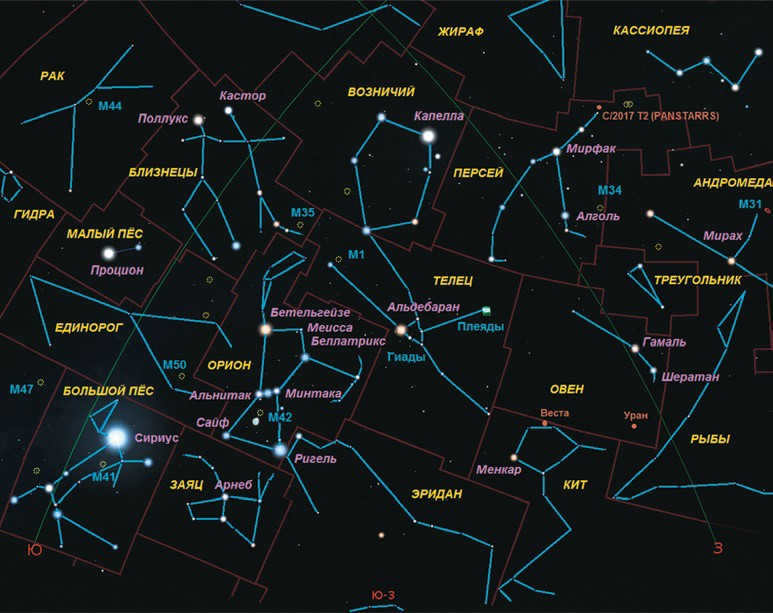
On December 22nd, we will experience the winter solstice, which marks the Sun’s farthest position from the celestial equator. During this time in the Northern Hemisphere, the Sun will appear at its lowest point above the horizon, resulting in the longest night of the year for astronomers to explore.
Winter presents a great opportunity to observe the various constellations that surround Orion, one of the most prominent and easily recognizable constellations in the night sky. In the midnight sky over Moscow, we can expect to see the Ascendant, Perseus, and Gemini rising high above the horizon. Additionally, Taurus, Orion, the Big Dog, and the Little Dog chasing the Unicorn will also be visible. These constellations offer a wealth of interesting objects to observe, but today we will focus specifically on Orion.
The Orion constellation is abundant in stars that are visible to the naked eye (ranking 8th among the 88 constellations in terms of brightness and 26th in terms of size), boasting 120 stars that shine brighter than magnitude 6. It has been recognized since ancient times, with some of its brightest stars serving as navigational aids. The earliest depiction of these stars, etched onto a mammoth bone, dates back over 30,000 years and was discovered in West Germany in 1979.
The recognizability of the constellation is determined by the shape created by the eight most luminous stars, which resemble either an hourglass or a bundle of wheat. Among these stars are two with a stellar magnitude of zero and five with a magnitude of second. In ancient times, people saw this shape as a representation of a human figure: the Greeks saw it as the hero Orion, who appeared in many myths, the Arabs saw it as a giant, the Egyptians saw it as the god Saha, and the Babylonians referred to it as the Heavenly Shepherd. The two stars Betelgeuse (α Ori, 0.2-1.2m) and Bellatrix (γ Ori, 1.64m) were seen as the hunter’s shoulders, while Rigel (β Ori, 0.12m) and Saif (κ Ori, 2.07m) were seen as his legs. Interestingly, the name Betelgeuse comes from an Arabic phrase meaning “twin hand,” and Rigel means “foot.” The three bright stars Alnilam (ε Ori, 1.69m), Alnitak (ζ Ori, 1.74m), and Mintaka (δ Ori, 2.25m) form the belt of Orion in the narrow, central part of the figure. The fainter star Meissa (λ Ori, 3.66m) represents Orion’s head.
The constellation of Orion, along with others, was delineated in 1930 by Belgian astronomer Eugène Joseph Delport. He used vertical and horizontal lines of direct ascension and declination, which are analogous to the lines of latitude and longitude on a globe. These lines appear as straight line segments in smaller areas and are depicted as such on contemporary star charts. However, due to the precession of the Earth’s rotation axis, these lines no longer align with Delport’s original construction for the B1875.0 epoch.
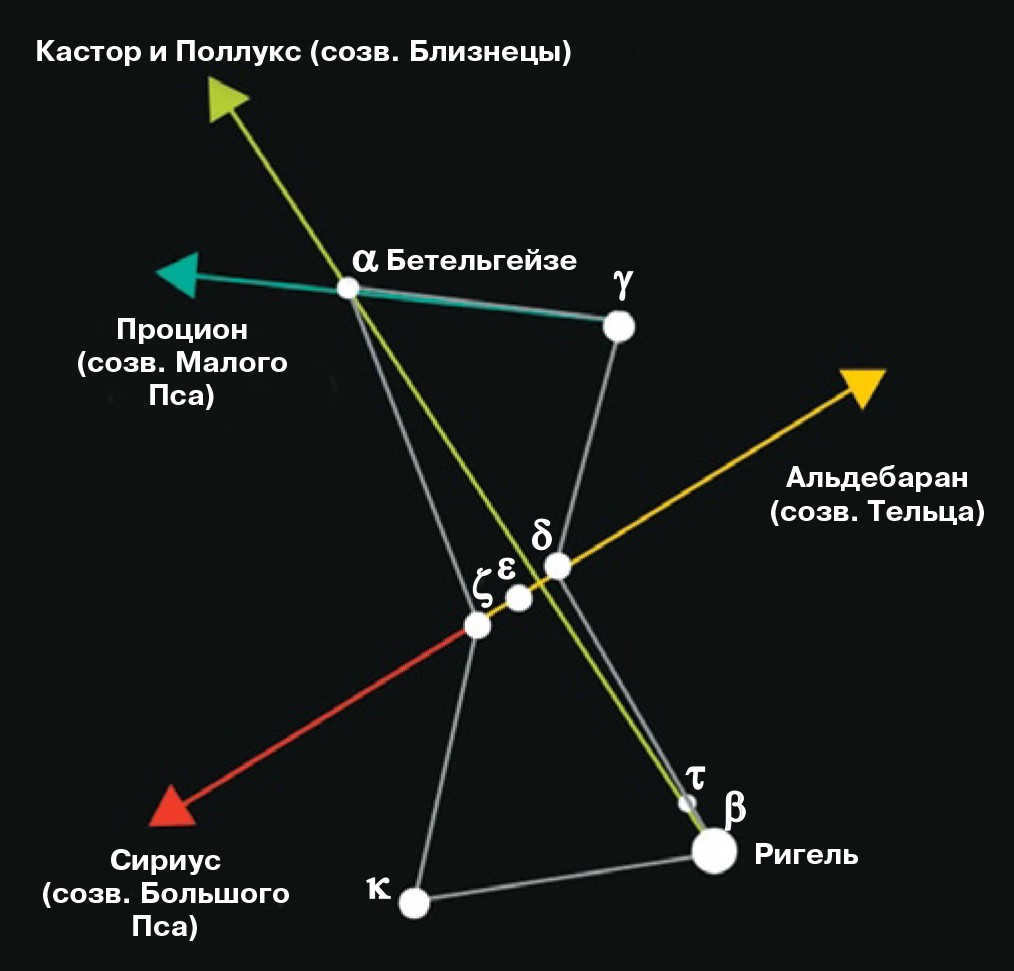
The physical attributes of these celestial bodies are equally remarkable. Rigel, situated in the Milky Way, stands out as one of the most potent stars, boasting a luminosity that surpasses that of the Sun by a staggering 120,000 times. In terms of size, Rigel is 21 times more massive than the Sun, with a radius 79 times larger. Additionally, its surface temperature is double that of the Sun. If Rigel were placed within our solar system, it would orbit Venus. This star, located at a distance of “only” 860 light years from us, holds the distinction of being the closest star with such an incredible luminosity.
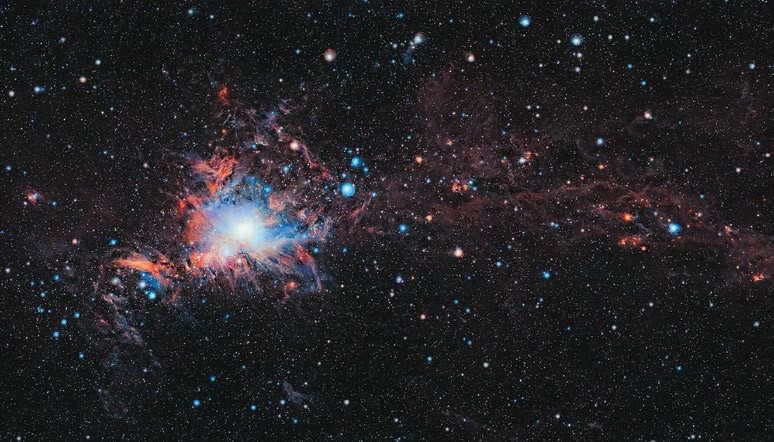
As an illustration, in July 2009, the Very Large Telescope Ground-based Interferometer (VLTI, ESO) captured pictures that unveiled an enormous gas flow stretching 30 astronomical units (a. e.) away from the star (equivalent to the space between the Sun and Neptune). In a similar vein, a research conducted in 2009 discovered that the star had decreased in dimensions by 15% over the course of 15 years!
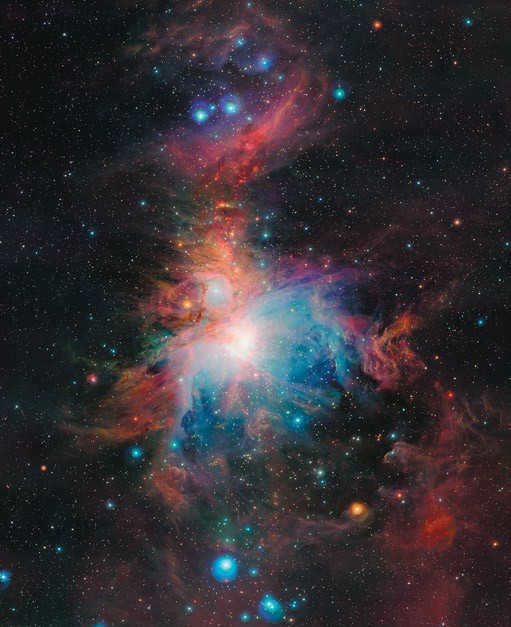
The Torch Nebula (NGC 2024) is a region where stars are currently forming. When viewed in visible light, the central part of the nebula is completely obscured by dark dust. However, a picture taken with the VISTA infrared telescope (ESO, Chile) reveals a cluster of extremely young stars at its core, as well as wispy streams of dust and gas that resemble smoke. Additionally, the right side of the image showcases a brilliant blue star called Alnitak, one of three prominent stars that make up Orion’s belt. Positioned below is the reflective nebula NGC 2023, which is also an active site for star creation. Furthermore, a single exceptionally bright young star has carved out a hollow space within the surrounding cloud. Lastly, in the bottom right corner, the distinct shape of the Horsehead Nebula can be observed.
Alnilam has a luminosity that is 537,000 times greater than the Sun, is 40 times more massive than the Sun, and is 32 times more massive than the Sun. Its surface temperature is 27,500 K. The main component of the triple star Alnitak has a luminosity that exceeds the Sun by a factor of 250,000, is more massive than the Sun by a factor of 33, and is larger than the Sun by a factor of 20; its surface temperature is 29,500 K. These stars appear fainter than Rigel due to their distances of 2000 and 1200 light-years respectively, as well as their high temperatures, which shift the maximum emission into the ultraviolet region that is invisible to the naked eye. Mintaka has a host star that is 24 times heavier and 70-90 thousand times brighter than the Sun. One of the hottest stars in the constellation is the blue-white giant Saif (B0), which has a temperature of about 26,500 K and a luminosity that is 57,000 times greater than the Sun’s. It is 15 times more massive than the Sun and 22 times larger. Its distance is approximately 650 light years.
All of these stars are young because their large mass causes hydrogen to burn quickly, resulting in rapid evolution and a short lifespan of a few million or tens of millions of years. This is in contrast to stars like the Sun, which can exist for billions of years.
However, the most interesting aspect for astrophysicists is the collection of giant molecular clouds in Orion, where there is an active process of star formation. These regions are often referred to as star nurseries. They are located at distances of 1000 to 1400 light-years from us and span several hundred light-years in the complex of clouds. The stars in these clouds are no older than 12 million years.
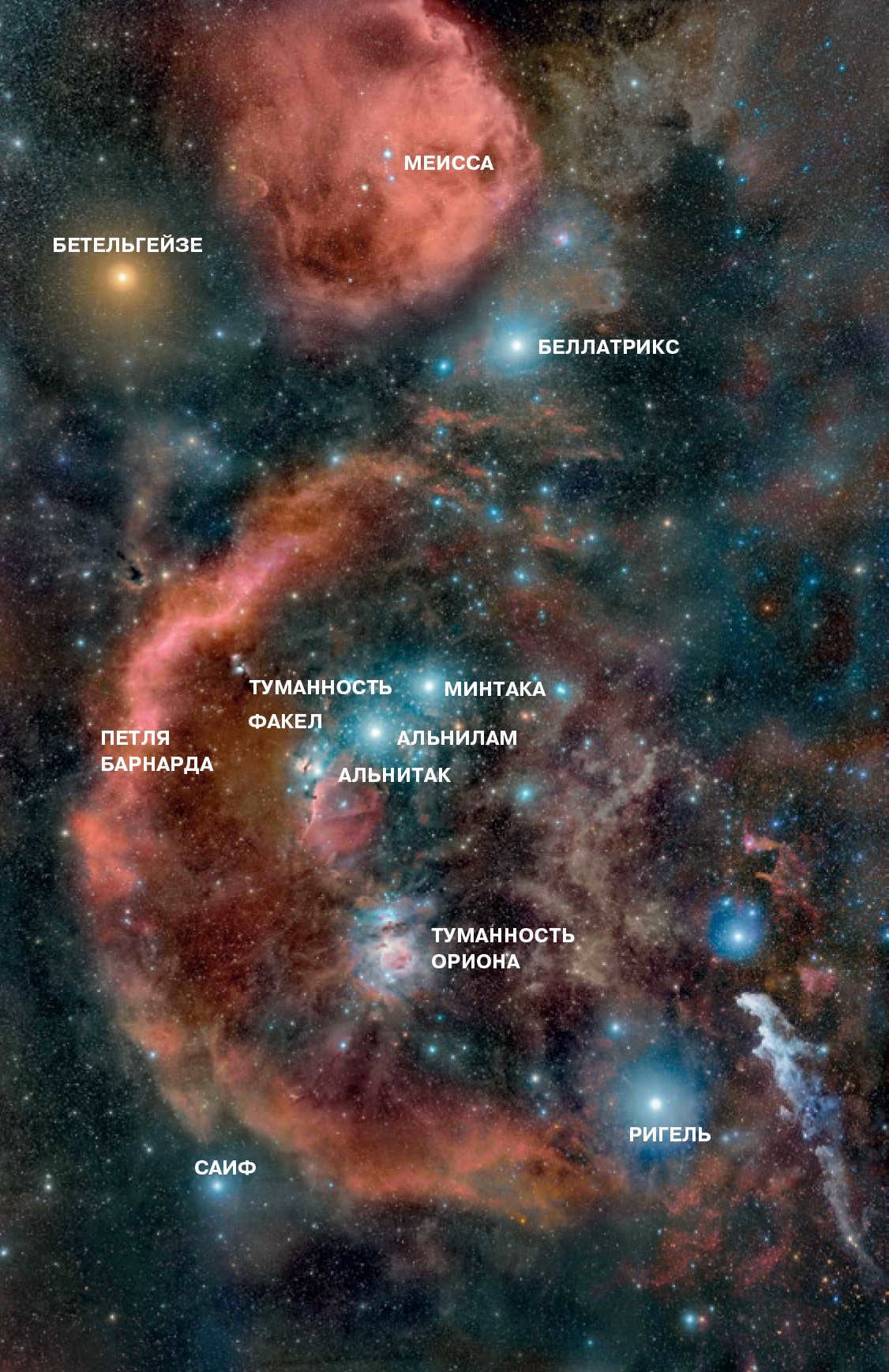
It is possible to observe certain nebulae within the complex using binoculars and small telescopes, while others, like the Orion Nebula (M42), can be seen with the naked eye. The fact that the Orion Nebula, also known as the Great Orion Nebula, is visible to the naked eye is not surprising, considering its immense size. In fact, the Great Orion Nebula is 15,000 times larger than the solar system and appears as an area in the sky four times the size of the Moon’s disk. Due to its significance, the Great Orion Nebula is extensively studied and explored by scientists.
There are other fascinating objects that can be observed within the Orion Cloud, such as the Flame or Torch Nebula (NGC 2024). This particular nebula serves as a remarkable example of the luminous effect produced by a massive hydrogen cloud under the influence of stellar radiation. At the center of this nebula resides a cluster of young stars. Another well-known nebula, the Horsehead Nebula (IC 434), should not go unnoticed. It appears as a dark silhouette against the backdrop of reddish-hued hydrogen clouds, influenced by the radiation emitted by Alnitak. This peculiar effect occurs because the gas and dust composing the Horsehead Nebula absorbs the radiation emitted by the clouds situated behind it. Under extremely dark skies, the naked eye can even perceive Barnard’s Loop, a nebula taking on the shape of a wide arc and positioned within the Orion Nebula. This loop stretches across 600 arc minutes (equivalent to 20 Moon diameters), covering a significant portion of the constellation. Its size is estimated to be anywhere between 100 to 300 light-years, depending on the distance. Estimates regarding the distance itself range from 500 to 1500 light-years. The origin of this nebula is attributed to a supernova explosion that occurred two million years ago. It is interesting to note that Barnard, the individual who took the first-ever photograph of this nebula and provided a detailed description of it in 1894, referred to it as Orion’s Loop.
Lastly, let’s discuss two recent discoveries that were reported in 2019. The ALMA telescope made observations revealing the presence of table salt (NaCl), potassium chloride (KCl), and other similar compounds in the protoplanetary disk surrounding the young star Orion Source I. The mass of these “salty” compounds and heavy elements was estimated to be about 1021 kg, which is roughly equivalent to the mass of Earth’s oceans. The abundance of these elements, often referred to as “metals” by astronomers, is crucial for our understanding of star and planetary system evolution. Typically, metallic compounds that are not bound to any specific object are undetectable by radio telescopes. However, this study suggests that this may change in the near future.
On November 26, 2016, the James Clark Maxwell Infrared Telescope (Hawaii, USA) detected the most intense flare connected to young stars in the Orion Cloud. This powerful flare, observed at submillimeter wavelengths, was ten billion times more energetic than the strongest solar flares. Astrophysicists attribute this event to the reshaping of the magnetic field caused by the stars’ rotation, known as magnetic line reconnection. This process also plays a significant role in solar phenomena.
Now let’s discuss what can be observed in the Moscow sky from objects within our Solar System.
Over the course of the winter months, the tireless Mercury will have the opportunity to explore six different constellations, following in the footsteps of Venus. It will begin the winter season in the middle of the Libra quadrant, but on December 11 it will venture into Scorpius for three days before continuing its journey through the Serpens constellation. On December 16, it will pass 5 degrees north of Antares (α Scorpius, 1.05m, M1) before moving on to Sagittarius starting from December 27, and then Capricorn starting from January 16. Finally, on February 1, it will complete its journey by crossing into Aquarius. However, instead of catching up with Venus, Mercury will change course and pass through the constellations of Neptune and Taurus on February 16. One month earlier, it will have the opportunity to meet other planets, passing 1.5 degrees south of Jupiter on January 2 and then 2 degrees south of Saturn on January 12, with Pluto in between.
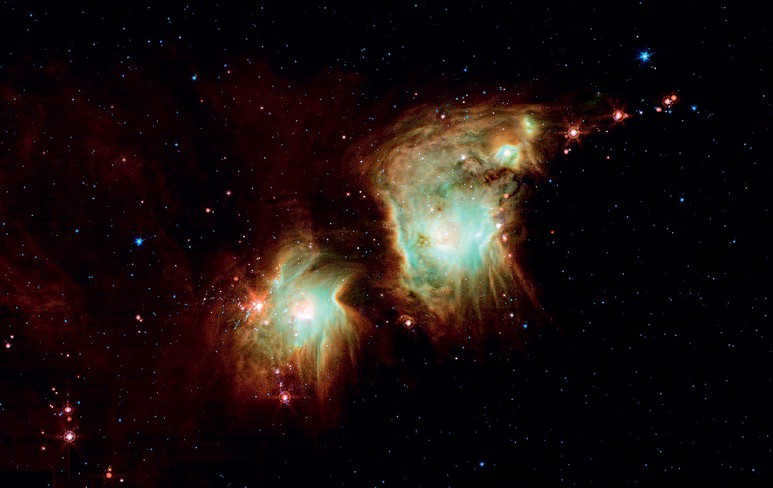
During the beginning of December, Mercury can be seen for one hour before sunrise, with its position in the sky reaching 8° above the horizon. However, as the month progresses, the conditions for observation will deteriorate, and by early January, Mercury will become obscured by the Sun’s rays. In the latter half of January, Mercury will reemerge in the evening sky and gradually regain its previous position. By February 10th, it will be visible for a two-hour interval and reach a height of 18° above the horizon. In the final weeks of February, Mercury will once again be visible in the morning sky, but only for a brief period of twenty minutes above the horizon.
The diameter of Mercury decreases from 6′′ to 4.7′′ in December, and then increases to 10.6′′ by the end of February. The phase increases from 0.74 to 1 in December before decreasing to nearly zero at the end of February. Due to these changes, the luminosity of Mercury increases from -0.6m to -1.4m (January 13) in the first half of winter, and then decreases to 5.2m.
Venus will enter Sagittarius in December, then transition to Capricorn on December 20, Aquarius on January 11, and finally Pisces on February 2, where it will remain for the remainder of the month. The conditions for observing Venus are steadily improving, and the winter months will be particularly favorable for viewing the second planet. In early December, Venus can be seen in the southwest for approximately two hours after sunset, with a maximum altitude of only 8° above the horizon. However, by the end of February, the observation time will extend to over four hours, and its altitude will increase to 34°. The visible diameter of Venus will also expand from 11.7′′ to 18.2′′, and its luminosity will increase from -3.9m to -4.3m. It is worth noting that the phase of Venus will decrease from 0.87 to 0.65.
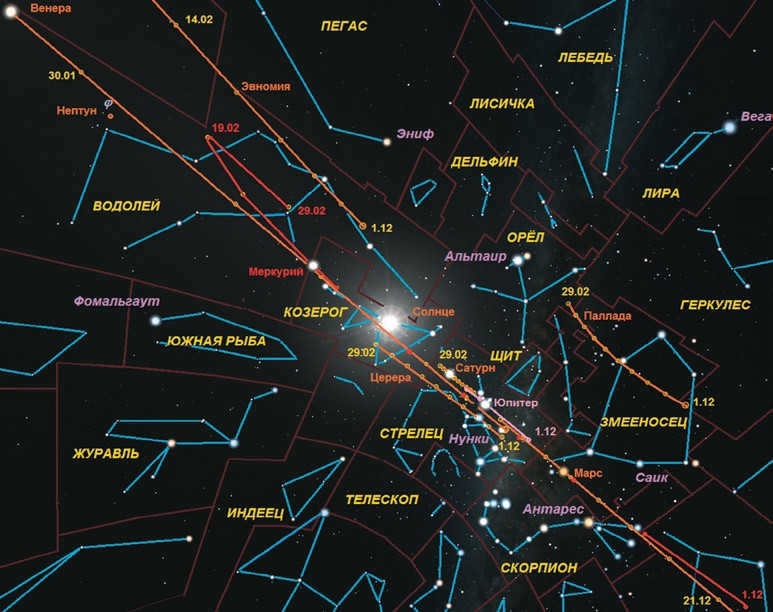
Venus is predicted to meet up with other planets as well. By December 1st, it will be in close proximity to Jupiter, and by December 11th, it will pass 1.8 degrees to the south of Saturn. On December 13th, it will come within 1.1 degrees to the south of Pluto. Finally, on January 27th, Venus will be incredibly close, just 0.1 degrees to the south of Neptune.
Jupiter is currently in the constellation of Sagittarius and is moving closer to Saturn. In December, it will be visible shortly after sunset and will be positioned low on the horizon, reaching a maximum height of 8 degrees. However, in the winter months, it is best observed in regions further south. Towards the end of December, Jupiter will become hidden by the Sun’s rays and will reappear in the morning sky after the new year. By the end of February, it will be visible in the morning sky for about one and a half hours. Jupiter will maintain its brightness of approximately 1.8m and has a diameter of around 33 arcseconds. Its phase is nearly 1.0.
Saturn is steadily approaching the border between the Sagittarius and Capricorn constellations. The duration of its visibility in the evening sky in December is decreasing from three hours to just one. Its position above the horizon is now no more than 11 degrees. By mid-January, it will become hidden from view due to its conjunction with the Sun on January 13th. However, in February, it will reappear in the morning sky, albeit still very low on the horizon. It will maintain a brightness of approximately 0.6 magnitudes, a diameter of 15 arcseconds, and a phase close to 1.0.
To observe Uranus, the winter months provide ideal conditions, although the time available for observation is shorter. While in early December, the planet sets below the horizon at five o’clock in the morning, by late February, this occurs before midnight. However, Uranus maintains a high level of brightness at 5.7m, and if there is no interference from the Moon or city lights, it can be seen with the naked eye, especially as it rises high above the horizon. It should be noted that the peak elevation, at 46°, shifts from midnight to just after sunset over the course of three months. The visible diameter of Uranus is approximately 3.5′′ and its phase is 1.0. Uranus is situated in the constellation Aries, approximately halfway between the stars Sheratan (β Aries, 2.6m) and Menkar (α China, 2.5m).
The period of time during which Neptune can be seen in the evening sky is also getting shorter. In the beginning of December, the eighth planet can be observed until midnight, but by the end of February, it will only be visible for less than an hour after sunset, which makes it challenging to spot. Neptune is situated in the constellation Aquarius, just south of the star ϕ Aquarius (4.2m). Its altitude reaches 29 o . The apparent size and brightness of Neptune stay relatively the same: 2.4′′ and 7.9m.
The first lunar eclipse of 2020 is scheduled to occur on January 10. This particular eclipse will be of the penumbral type, as the Moon will pass through the northern part of the Earth’s penumbra. The eclipse is set to begin at 20:07 and will conclude at 00:12 Moscow time. The maximum phase of the eclipse, which will have a magnitude of 0.92, will last for approximately one hour, from 21:40 to 22:40. It’s worth mentioning that the initial and final stages of the penumbral eclipse are hardly visible to the naked eye. The true darkening effect on the Moon’s disk becomes noticeable when approximately two-thirds of the disk is immersed in the penumbra. It’s important to note that atmospheric conditions and visual acuity can also impact one’s ability to observe the eclipse. Fortunately, the eclipse will be visible across the entire country of Russia.
Sunrise and sunset times for the Sun and planets (rounded up)

In December, in contrast to the months that follow, there is a wealth of meteor showers. One of the most fascinating and most intense meteor showers, the Geminids, can be observed at the beginning of the month. The radiant of this meteor shower is located in the Gemini constellation near Castor. The Geminids are active from December 4th to 17th, with the peak occurring on December 12th to 13th, during which up to 100 meteors per hour can be seen. In 2011, there were even up to 200 meteors per hour. Unfortunately, this year the peak of the shower coincides with a full moon, and the Moon is in close proximity to the radiant, making observations quite challenging. However, there are often bright meteors and bolides in this meteor stream, which can still be partially observed by blocking out the light from the Moon.
During the entire period of darkness from December 28 to January 12, there is a remarkable meteor shower known as the Quadrantids. The radiant of this meteor stream is located in the constellation Volopassus, near the border with the constellation Dragon. In the early morning hours, the radiant rises to nearly the highest point in the sky, reaching the zenith. The peak of this meteor shower is expected on January 4th. The intensity of the Quadrantids ranges from 60 to 200 meteors per hour.
The Different Stages of the Lunar Cycle

The Moon will approach celestial bodies (S – south, N – north).
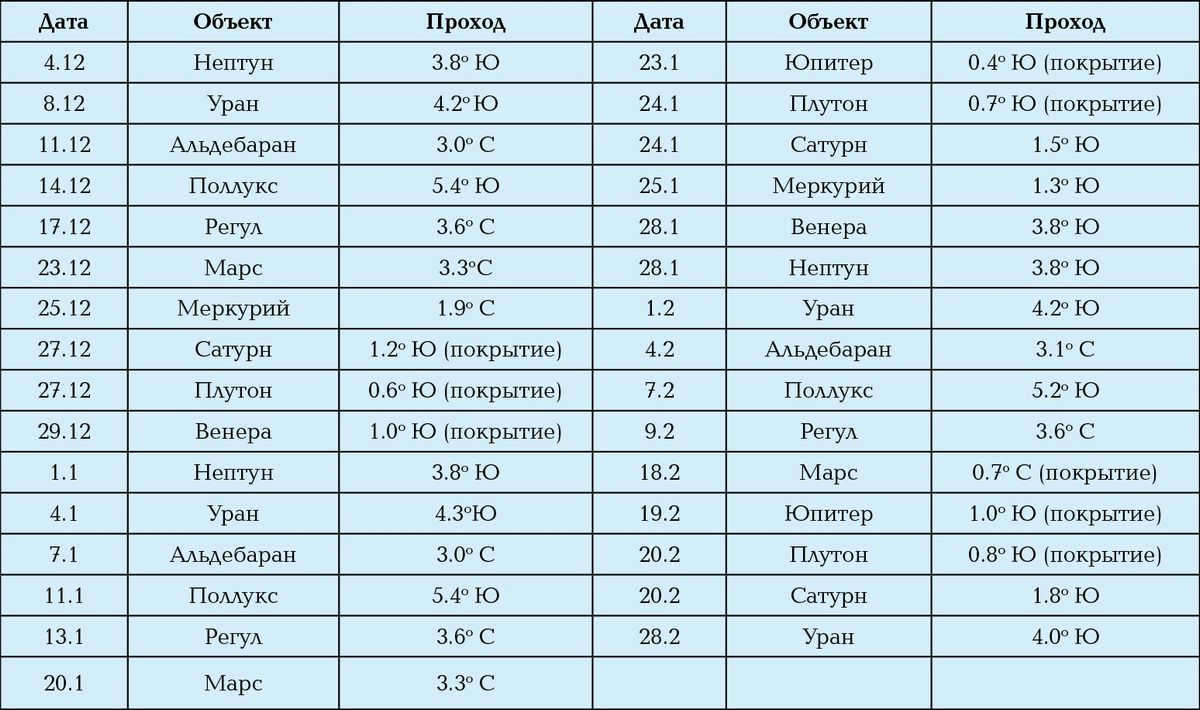
Stellarium program is used to create maps of the sky. The images are derived from the ESO/VISION survey and ESO/J. Emerson/VISTA, with a photo contribution by Rogelio Bernal Andreo/Wikimedia Commons/CC BY-SA 3.0. The source of this information is NASA’s Spitzer Space Telescope.
To access the rest of the article, please provide authorization. It’s a quick and free process.
Ancient civilizations devised a way to navigate the celestial expanse by identifying constellations that resembled various objects, mythological figures, and animals. This classification system allowed for easy recognition and organization of the night sky.
It became simpler to examine celestial objects, to gauge time, to implement astronomical understanding to farming, and to navigate using the stars. The stars that we perceive in the sky as if they were in close proximity can actually be separated by vast distances. There may be unconnected stars in the same constellation, some of which are near to Earth and others that are far away.
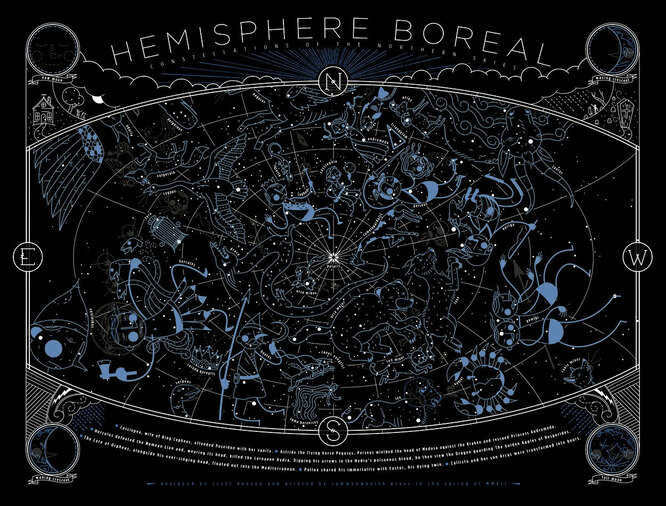
The Legend of Cassiopeia
In ancient Greek mythology, Cassiopeia was the wife of Cepheus, the king of Ethiopia, and together they raised their daughter Andromeda.
Once, Cassiopeia boldly claimed that she and her daughter were more beautiful than the Nereids, the sea nymphs. Despite her ethereal beauty, the queen possessed a haughty and arrogant nature. This act of insolence infuriated Poseidon, who was married to a sea goddess and had a close connection with the Nereids. As a result, he unleashed a sea monster upon Ethiopia, which wreaked havoc and destruction upon the land each day.
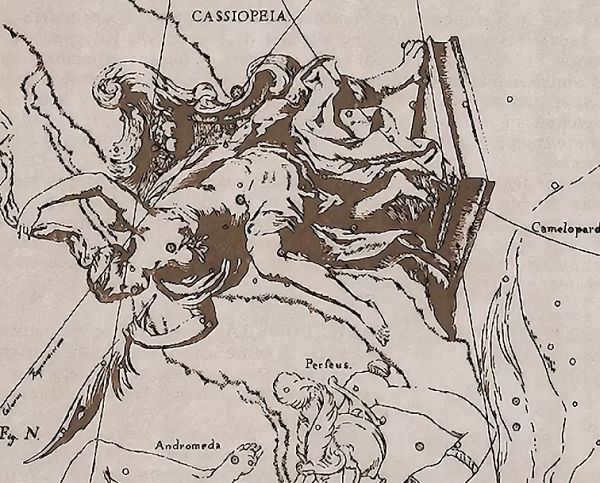
The oracle of Ethiopia declared that the only solution to vanquish the dragon was to offer the daughter of the ruler of Ethiopia, the beautiful Andromeda, as a sacrifice.
Though Cassiopeia and her spouse were reluctant to part with their beloved daughter, the desperate citizens of the kingdom impelled them to comply with Poseidon’s demand. Consequently, the unfortunate girl was shackled to a boulder and left to await her imminent demise. Meanwhile, Perseus soared through the heavens astride his winged horse Pegasus.
At first glance, he was captivated by the enchanting maiden. The valiant hero vowed to rescue the princess from the sea monster, on the condition that he could claim her as his own bride. Cassiopeia granted permission for the union, yet failed to disclose that Andromeda was already betrothed to Phineas.
Once Perseus had beheaded the fearsome dragon Kit (according to one account, using the sword of Hermes), Andromeda’s parents gave their joyous consent to the marriage. In the midst of the wedding preparations, Perseus found himself engaged in a fierce battle against Phineas and his warriors. He valiantly slew many adversaries, and some were even turned to stone when they gazed upon the head of Medusa. Following the wedding festivities, Perseus set sail with his young bride to the enchanting island of Seriphos.
Researchers theorize that the myth of Cassiopeia has its origins in the East, as evidenced by the similarities between the names and locations in the myth and those found in the East.
The most fascinating constellations
Undoubtedly, all the constellations in the celestial sphere and their designated names (depicted underneath) are remarkably distinct. Numerous constellations possess their own remarkable folklore, captivating mythology or extraordinary formations. Among these, the Goldfish and Toucan constellations stand out. The former encompasses the awe-inspiring Large Magellanic Cloud, while the latter features the mesmerizing Small Magellanic Cloud. Both of these celestial bodies are truly extraordinary.
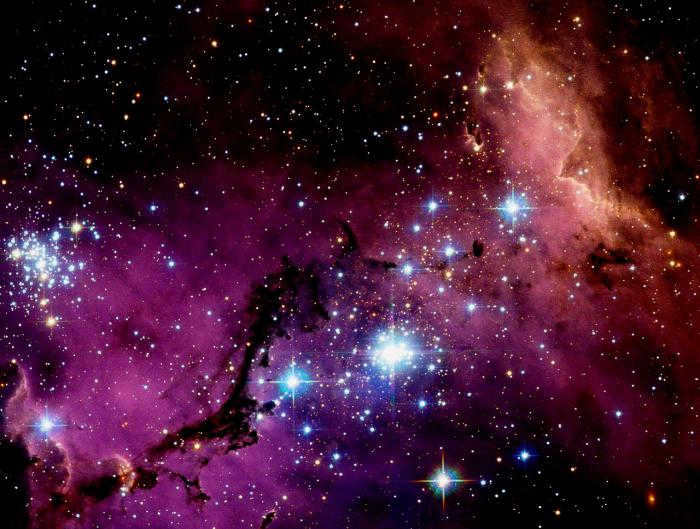
The Large Cloud bears a striking resemblance to a Segner wheel, while the Small Cloud resembles a punching bag. Both clouds are expansive in the sky, often compared to the size of the Milky Way, although they are actually much smaller. They seem like fragments that have broken away from the Milky Way but maintain a similar composition. Remarkably, these clouds are also the nearest star systems to our own galaxy.
What is truly astonishing is that our galaxy and the Clouds can orbit around a common center of gravity, creating a triple star system. Each component of this celestial trio possesses its own unique star clusters, nebulae, and other cosmic entities.
While there are officially 12 zodiacal constellations, it is customary to acknowledge the existence of an additional, or rather, easily overlooked Serpentine constellation.
The reason for this is that during the era of the zodiac, the precise boundaries of the constellations had not yet been determined mathematically. Instead, areas of the sky were identified visually by the presence of characteristic bright stars. It was only in the first half of the 20th century that the sky was divided into clearly defined constellations, revealing that due to the close proximity of the Serpent and Scorpio constellations, the ecliptic passes not only through the 12 zodiacal constellations, but also between Scorpio and Sagittarius, through the Serpent. In fact, the Sun spends even more time in the Serpent than it does in Scorpio.
Therefore, individuals who are born between November 30 and December 17 can rightfully consider themselves not Scorpio or Sagittarius, but rather Serpent horoscope. However, astrologers disagree with this notion, stating that the Zodiac is not connected to the constellations, but rather an imaginary circle divided into 12 sectors of the ecliptic, each measuring 30 degrees. The constellations are simply assigned to these sectors for convenience in everyday life.
Because of this, the Serpent has never been included in the “official” zodiac.
The Big Dipper, covering an area of 1279.660 square degrees.
The Big Dipper encompasses approximately 3.102% (equivalent to nearly 1,280 square degrees) of the celestial sphere in the northern hemisphere, and is visible from latitudes +90 to -30.
Renowned for its distinctive shape, the Big Dipper is composed of seven prominent stars that create an asterism bearing the same name. However, the constellation itself is home to around 209 stars, with the brightest being Aliot, situated at a distance of 81 light-years from Earth.
Not only is the Big Dipper one of the most easily recognizable constellations in the night sky, but it also holds significant cultural and mythological importance, just like other prominent constellations such as Orion and the Southern Cross. It has been revered since ancient times and plays a prominent role in various civilizations and mythologies.
Northern and Southern Constellations
Due to the spherical shape of the Earth and its orbit with a slight tilt, different constellations can be seen in the northern and southern hemispheres. However, there are some constellations that can be seen in both hemispheres, particularly those located in the region of the celestial equator, which may rise above the horizon at certain times of the year.
The majority of constellations that are visible in the middle latitudes of the northern hemisphere cannot be seen in the southern hemisphere. These constellations are referred to as “northern constellations”. Conversely, many constellations in the southern hemisphere are never visible in the northern hemisphere. This is especially true for the polar constellations.
Out of the 88 constellations, a total of 36 are classified as northern constellations, while the remaining 52 are considered southern constellations. However, it is worth noting that there are some constellations that can be seen in both the northern and southern hemispheres, although they may not rise high above the horizon. For example, the Big Dog with its bright star Sirius, which is typically associated with the southern constellations, can be easily observed in the winter months in the middle latitudes of the northern hemisphere. Additionally, the constellations Hydra, Unicorn, Whale, and a few others can also be partially or fully visible in both hemispheres.
Inventory of zodiac constellations
Astrologers utilize 12 of these star formations as astrological symbols, excluding the Serpentine to ensure that the predictions are accessible to all. Unlike astronomy, astrology is not regarded as a scientific field of study. The zodiac signs differ from the constellations, only loosely correlating with one another.
For instance, the sign of Pisces corresponds to the ascension of the Aquarius constellation. Interestingly, if you were born under a specific zodiac sign, the corresponding constellation is not visible during the nighttime. Instead, the Sun passes through it during this time of year, designating this day as the unobservable constellation’s day.
Shapes are created in the starry sky by constellations, but the stars themselves do not form specific shapes in outer space. The distance from our world to individual stars within a constellation can vary, often by tens of light years, resulting in stars being scattered randomly throughout the galaxy.
The images we see at night are formed because we can only perceive two dimensions in the night sky, lacking the depth that exists in reality.
However, the zodiacal constellations continue to serve as landmarks and inspire the imagination. They assist observers in their search for planets, comets, and other celestial phenomena. They provide a convenient reference point in the night sky.
Utilize our online models to observe all 13 zodiacal constellations in the sky, along with the brightest stars.
Overview
There are a total of eighty-eight constellations officially recognized. Out of these, only forty-seven have been documented since ancient times. Credit is due to the astronomer Claudius Ptolemy, who organized the familiar constellations of the celestial sphere in his work “Almagest”. The remaining constellations emerged as humanity delved deeper into understanding the universe, exploring more extensively, and documenting their findings. As a result, additional clusters of celestial objects became apparent in the night sky.
The sky is adorned with a multitude of constellations, each with its own unique name (you can find photos of some of them in this article). These constellations often have multiple names and are accompanied by ancient tales of their origin. One intriguing legend tells the story of the creation of the Big and Little Bears in the celestial realm. In a time when the gods reigned supreme, Zeus, the most powerful of them all, found himself captivated by the beauty of the nymph Callisto. He took her as his wife, but to shield her from the jealous and perilous Hera, Zeus transformed her into a bear and placed her in the heavens. Thus, the constellation of the Big Dipper came into existence, while Callisto’s loyal companion became the Little Bear.
Tales and myths surrounding the constellation
Throughout history, humanity has been captivated by the wonders of the night sky, seeking to understand the mysteries of the universe. Ancient civilizations, devoid of the advanced technology we possess today, relied on their imagination to explain the celestial bodies. This gave rise to a plethora of extraordinary legends, many of which have endured over the ages.
The tale of the constellation Cassiopeia was no different. Situated in the Northern celestial hemisphere, this cluster of stars has captivated and intrigued the ancient Greeks, who crafted a fascinating legend around it.
According to the myth, there once existed a king named Cepheus who ruled over Ethiopia. He had a young and stunningly beautiful wife named Cassiopeia, after whom the entire constellation was named. Under Cepheus’ rule, the kingdom thrived until the sea nymphs grew tired of his wife’s arrogant and conceited behavior. They complained about her to Zeus, the mighty thunderer, who could no longer tolerate her incessant bragging and pride.
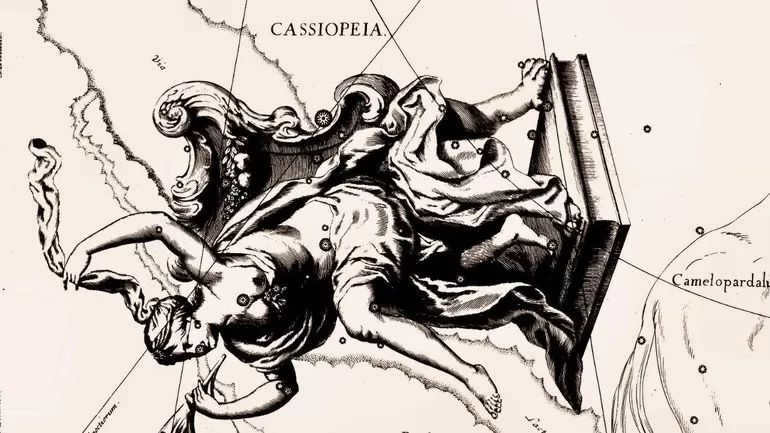
The ruler of the heavens, Zeus, was filled with rage and unleashed a fearsome punishment upon the land of Ethiopia. This punishment took the form of a colossal sea creature known as Kit, which would periodically terrorize the country’s inhabitants by dragging them down into the depths of the abyss. Faced with this horrifying threat, the king of Ethiopia grew desperate and dispatched messengers to reach out to Zeus, who happened to be in neighboring Libya at the time. However, the mighty thunder god remained unyielding, stating that he would only subdue Kit if he was offered the hand of Cepheus’ daughter, the young and beautiful Andromeda, who would be sacrificed to the merciless monster.
Naturally, the father opposed the desires of the powerful Olympian, as he did not wish to sacrifice his only daughter, but his fearful people held a different viewpoint, resulting in Andromeda being seized and bound to a cliff along the coast. Thankfully, Perseus, the conqueror of the dreadful Medusa, happened to be flying by at that precise moment. The demigod caught sight of the captivating young woman and was determined to liberate her at any cost.
However, it was at that very instant that Kit emerged from the depths of the sea and resolved to claim the promised offering in the form of Andromeda. A clash ensued between him and Perseus, in which the latter emerged victorious. Seeing the heroism displayed by all the characters, the gods decided to elevate them to the heavens, resulting in the creation of a constellation and the corresponding naming of the celestial bodies, as the legend’s plot unfolds.
Starting the introduction to the stars with a captivating story is likely to capture the child’s attention and pique their interest in the subject.
Further details about the discovery
This constellation has a long history, with the first recorded mention of it found in an ancient astronomical catalog compiled by Claudius Ptolemy, a scientist from the late Hellenistic era who resided in Alexandria, Egypt. The primary name of this star cluster was derived from Greek mythology, although an alternate name was discovered in certain Arabic manuscripts, which translates to “sitting woman”.
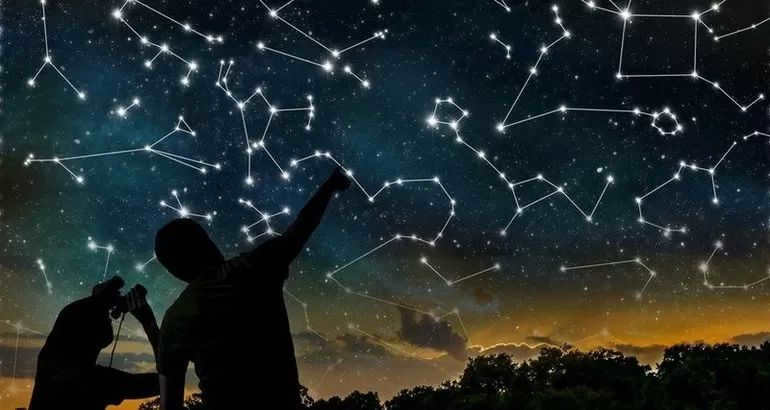
Star formation can be easily observed across most of Russia. For those unfamiliar with the appearance of the Cassiopeia constellation, a simple reference point can be used. Just draw a straight line between the Big Dipper and Polaris to view this prominent group of stars.
Constellations in the Winter, Spring, Summer, and Fall Skies
The Earth completes a full revolution in its orbit over the course of a year, resulting in different constellations being visible in the nighttime sky. If we had constant darkness, we would be able to see all constellations during the day as well. However, due to the presence of daytime, the celestial display gradually changes at night.
Constellations can be categorized as winter, spring, summer, or fall constellations based on the time of year when they are most prominently visible. For instance, Orion is a prime example of a winter constellation. It rises in the eastern sky in late fall, reaches its peak visibility in mid-winter, and sets in the western sky during spring.
Constellations located near the poles are referred to as polar constellations and can be seen throughout the year. The only variation is their height above the horizon.
- Winter constellations
- Spring constellations
- Constellations of the summer
- Constellations of the autumn
What are the Pleiades?
The Pleiades are a cluster that consists of a large number of stars. While only seven stars are visible to the naked eye, dozens can be seen with binoculars, and even hundreds with a small telescope. Scientists estimate that there are 1200 stars in the Pleiades cluster, all of which are connected by gravity. This means that it is not just a random group of stars that happen to be in the same direction, but rather a large system that formed from a single nebula.
The Pleiades cluster is only 115 million years old, making it a very young cluster. In comparison, our Sun is much older at 4.5 billion years. Therefore, most of the stars in the cluster are young and hot. However, approximately 25% of the stars are brown dwarfs, which are very faint and small.
The cluster contains a total of 12 stars, each of which shines more brightly than a magnitude of 6. These stars can be observed without the aid of a telescope, provided that one’s vision is exceptionally sharp and the sky is exceptionally clear. All of the stars in the cluster are classified as blue-white giants and subgiants, which are significantly larger, brighter, and hotter than our own Sun.
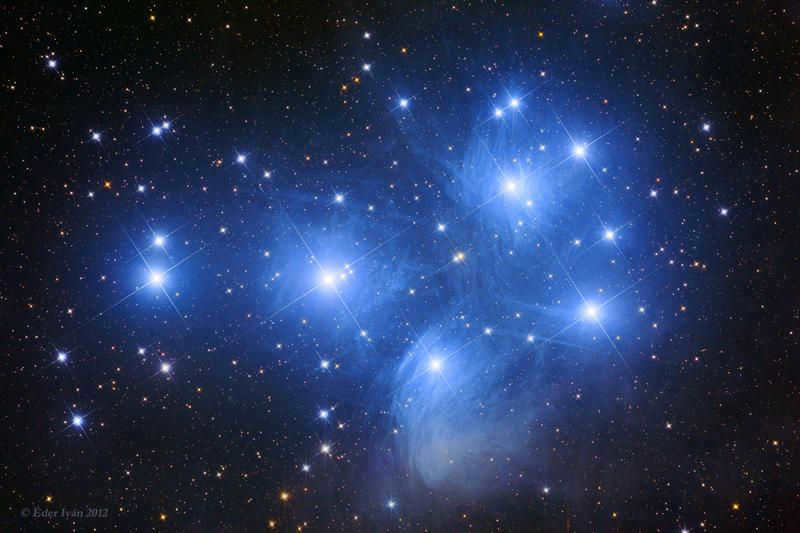
In the image provided, it is evident that there are clusters of stars surrounded by nebulae. Previously, it was believed that these nebulae were remnants of the same nebula that gave birth to these young stars. However, recent discoveries have shown that they are unrelated – the Pleiades cluster simply happens to be passing through a dust cloud that coincidentally lies in its path. The bright stars within the cluster illuminate the dust cloud, making it visible to us. Interestingly, the stars within the cluster and the nebula are moving in different directions, with a relative velocity of 11 km/s.
The constellation Hydra covers an area of 1302.844 square degrees.
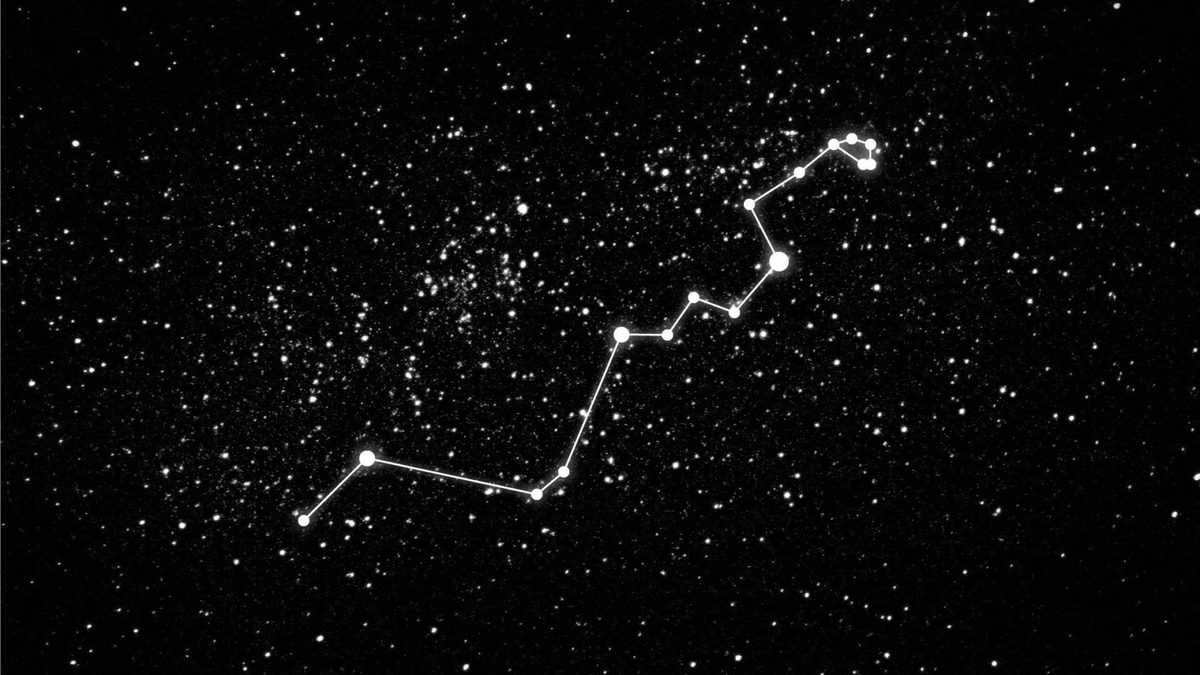
Hydra, which is also known as the “Water Snake,” dominates approximately 3.158% (1302 square degrees) of the night sky, making it the largest constellation in the night sky.
This constellation, primarily visible in the southern hemisphere, can be observed between +54 and -83 latitude, with the best viewing conditions occurring in April. Hydra’s head is situated south of Cancer, while the remainder of its lengthy and sinuous body extends towards a point between Centaurus and Libra, where its tail ultimately concludes.
Hydra encompasses roughly 238 stars, but it is primarily composed of an asterism consisting of 17 stars. Among these stars, the brightest is Alphard, an orange giant located 177 light-years away. In Greek mythology, Hydra is associated with the Lernaean Hydra, which was one of the Twelve Labors of Hercules.
We observe distinct constellations throughout the year
As the Earth orbits around the Sun, various sections of the sky and corresponding celestial bodies become visible at different times. The constellations that grace our night sky are located on the opposite side of the Earth from the Sun, making them invisible during daylight hours when the Sun’s intense glare obscures our view.
To gain a deeper comprehension of the mechanics involved, envision yourself on a merry-go-round (representing the Earth) with a brilliantly radiant light (symbolizing the Sun) emanating from its core. Due to the intensity of the light, your line of sight will be obstructed, allowing you to only perceive what lies beyond the carousel. As you continuously circle around, the scenery will constantly shift. The specific constellations and the time of year they become visible in the sky are contingent upon the observer’s geographic latitude.
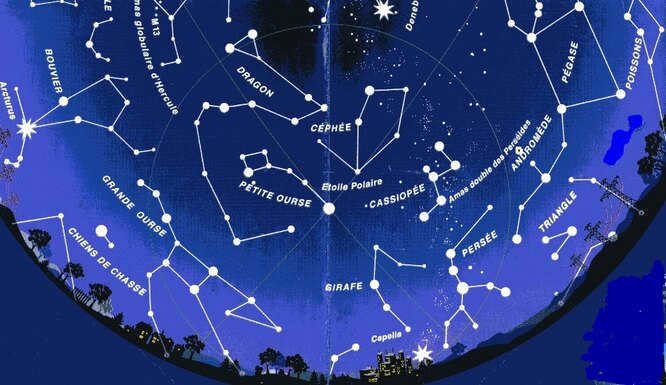
Constellations in the northern hemisphere – a list with images
Regrettably, it is not possible to observe all 28 constellations in a single night, as the laws of celestial mechanics are unforgiving. However, in exchange, we are presented with a delightful variety. The winter and summer skies exhibit distinct differences.
Let us discuss the most captivating and prominent constellations.
The Big Dipper serves as a prominent landmark in the night sky, aiding in the identification of other celestial objects.
The tip of the Little Bear’s tail is home to the renowned Polaris, also known as the North Star. Celestial bears possess elongated tails, unlike their earthly counterparts.
The Dragon is a sizable constellation situated amidst the Bears. Noteworthy within the Dragon is the star μ, referred to as Arrakis, which translates to “dancer” in ancient Arabic. Additionally, Kuma (ν of the Dragon) is a binary star, observable through regular binoculars.
Cassiopeia’s ρ is widely recognized as a supergiant, shining hundreds of thousands of times brighter than the Sun. In 1572, Cassiopeia experienced its most recent explosion.
There is a disagreement among the ancient Greeks about the ownership of Lyra. Different legends attribute it to different heroes – Apollo, Orpheus, or Orion. The famous Vega is a part of Lyra.
Orion is the most prominent constellation in the night sky. The three main stars of Orion’s belt are commonly referred to as the Three Kings or Magi. The renowned Betelgeuse can be found here.
Cepheus can be observed throughout the year. In 8,000 years, one of its stars, Alderamin, will become the new North Star.
The M31 nebula is located in Andromeda. It is a neighboring galaxy that can be seen with the naked eye on a clear night. The Andromeda Nebula is situated 2 million light years away from us.
The name Veronica’s Hair is derived from an Egyptian queen who offered her hair as a sacrifice to the gods. Located in the direction of Veronica’s Hair lies the north pole of our galaxy.
Arcturus, the alpha star of Volopas, is widely renowned. Further beyond Volopas, at the outermost boundary of the observable universe, lies the galaxy Egsy8p7. It holds the distinction of being one of the farthest objects ever detected by astronomers, situated a staggering 13.2 billion light years away.
Returning to Ancient Times
Ancient Greece, often referred to as the birthplace of civilization, has greatly influenced modern society. It is truly remarkable how, with limited resources and a basic understanding of the universe, they were able to provide answers to numerous questions.
The night sky is filled with an overwhelming number of stars, but how did people navigate through this apparent chaos? Upon closer inspection, one can discern a certain order. To simplify the process of studying the stars, the Greeks grouped them into constellations, forming recognizable patterns that resembled various creatures, deities, or mythological heroes.
Fascinatingly, these stars are often not physically close to each other or even on the same plane. However, they appear to be in close proximity when observed from Earth.
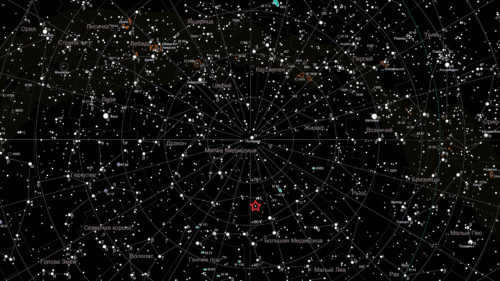
The most luminous celestial body is undoubtedly the Sun. Its luminosity is determined by its size, the amount of light it emits, and its distance from Earth. Due to its proximity to our planet and its immense light and heat output, the Sun is considered to be the brightest star. However, if we consider the entire cosmos, it is not the brightest.
Other luminous objects include:
The Toucan and Goldfish constellations are both unique and extraordinary. Each contains the Megellanova cloud, which is always a point of interest for astronomers. It resembles a boxer’s glove in appearance and occupies a significant portion of the sky. Scientists concur that it is a scaled-down version of the Milky Way.
Zodiacal constellations
The constellations found within the zodiacal circle are distinguished not only in the field of astronomy, but also in the realm of astrology, a pseudoscience. Regardless, both fields are based on the same principle: zodiacal constellations are those constellations which the center of the Sun passes through during its annual journey along the ecliptic. The term “zodiac” historically derives from the word “animal”, as it is connected to the names of half of the constellations within the circle.

